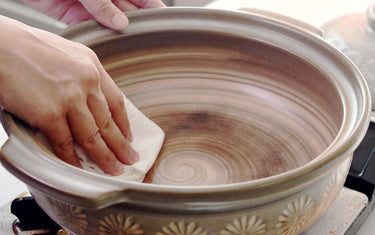This section describes how to maintain and use Donabe casseroles (earthenware pots).
The product we used:
Preparation before use
First, we will show you how to treat and "Medome" the pot before use. When using an earthenware pot for the first time, please perform this process.
Medome prevents water from entering the invisible microscopic holes in the clay pot, preventing cracking and odor from setting in.
1. Boil water

Fill the earthenware pot with water to about 80% full and then, boil over heat.
2. Add flour

When the water comes to a boil, reduce the heat to low, turn in the flour dissolved in water, and put over low heat for 5 minutes.
The amount of flour used should be about 1 tablespoon for a 7 go-size pan, 3 tablespoons for 9 go-size, and 5 tablespoons for 11 go-size.
3. Cool off

Turn off the heat and leave it until naturally cool down.
4. Washing

Discard the water from the pot, rinse the pot well under running water, and then dry it to done.
Care after use
Here are some tips on how to care for your earthenware pot after use.
Wash with water

Transfer the soup left in the earthenware pot to another container as soon as possible and rinse the pot with water. If grease stains are difficult to remove, use an appropriate amount of mild detergent.
Do not rub hard

Scrub gently when cleaning, as hard scrubbing may cause damage. Also, wash with a sponge, scrubber, etc.; do not use a gold scrubber.
Dry thoroughly

After washing, dry the earthenware pot in a well-ventilated place with the top and bottom of the pot upside down. If soup is left in the pot for a long time or soaked in water, the clay pot will absorb water and become brittle, causing cracks or other damage.
How to maintain earthenware pots
Here is what to do when a problem occurs with the clay pot.
In case of burnt

If the bottom of the pot is burnt, boil a pot full of water and leave it boiling for 2 to 3 minutes to make it easier to remove the burnt.
If it's unable to remove the burnt, add about 2 tablespoons of baking soda, boil, turn off the heat, and let it sit until cool.
In case of odor

If the earthenware pot has an odor, use tea leaves to remove the odor. Boil a full of water, add a tablespoon of tea leaves and simmer over medium heat for 10 minutes and you are done.
In case of getting moldy

If it's getting moldy, use the vinegar for sterilizing and deodorizing. Boil a pot full of water, add a few tablespoons of vinegar, and boil for 10 minutes. Mold stains may remain, but the mold itself will be killed and prevented from reproducing.
If vinegar is not available, lemon juice or citric acid can be substituted.
Precautions for use
Earthen pots are susceptible to sudden temperature changes and may crack if heated too quickly. In particular, when cooking, it is strictly prohibited to heat the pot while the bottom is still wet, to heat the pot over high heat from the beginning, or to burn the pot when it is empty.
When cooking, wipe off the water from the bottom of the pot before placing the earthenware pot on the heat, and start heating it over low to medium heat at first. Also, when cooking over a long period of time, periodically add water to the pot to prevent the water from evaporating and causing the pot to burn dry.
How to storage

Water and moisture are the enemy of highly absorbent earthenware pots. Please dry them thoroughly when storing them. Storing the pot with moisture or in a humid place can cause mold.
For long-term storage, store in a dry place by wrapping in newspaper or placing dehumidifying agents inside the pot to prevent moisture.
Let's Enjoy Japanese Dishes with a Donabe Casserole!
Earthen pots are indispensable cooking vessels for traditional Japanese hot-pot dishes. With one earthenware pot, you can enjoy many variations of hot-pot dishes. Please use earthenware pots correctly and enjoy traditional Japanese cooking.














